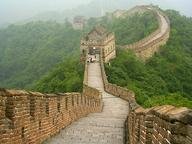Quiz Answer Key and Fun Facts
1. One of the most famous places in China is a large space in central Beijing, bounded by imperial palaces and national museums. A giant portrait of Chairman Mao hangs at one end; his tomb is underground at the other; and in between a 1989 pro-democracy demonstration was infamously and brutally put down. We will begin our tour here; where are we?
2. Let's tour the Forbidden City, a tremendous imperial palace complex. The City's gleaming tile rooftops evoke ancient pomp and circumstance; meanwhile, as we travel through some of the 980 surviving rooms, we'll see artistic masterpieces going back thousands of years. Some of the most beautiful imperial pieces are no longer here, however: they were stealthily evacuated in 1947. Where can the remainder of the Palace collection be seen?
3. After an extended trek through the Forbidden City, what we need is a tranquil place to rest and regroup. Luckily, the beautiful Beihai Park is just northwest of the palace complex. We'll stroll along peaceful pathways, admire the temples and pavilions, and enjoy the unusually serene scenery. Around what type of geological formation is Beihai Park centered?
4. We're visiting a religious complex, a cluster of beautiful Ming buildings set in a spacious park. Emperors from the Ming and Qing dynasties came here twice every year on ceremonial occasions, to intercede with the gods on behalf of their people at such altars as the Hall of Prayer for Good Harvests. What is the name of this holy place?
5. Try to hold on to those spiritual feelings, as we're about to visit a Tibetan Buddhist monastery, one of the grandest in the world. The halls of Yonghegong, informally known as the Lama Temple, are home to nearly a hundred monks of the Yellow Hat sect. This magnificent complex was not always a religious one, however. Before 1722, how were these buildings used?
6. Making our way southwest to our last stop in the old city, we'll walk through several hutongs -- traditional Beijing neighborhoods built up around alleyways, now endangered by the modernization of the city. Some of the best-preserved hutongs are clustered around the two towers that once musically announced the time for imperial Beijing. What are these towers, each named for the instrument that was sounded there to mark the passing of the hours?
7. We'll leave Beijing's old city for a northwestern jewel: the Summer Palace. Long the site of imperial gardens, the shores of Kunming Lake were converted to the full-fledged imperial resort we're about to tour -- complete with courts, operatic stages and shrines -- in the nineteenth century. In the public imagination, the Palace is inexorably linked with the extravagant reputation of an Empress Dowager, the last real ruler of the Qing Dynasty. What was her name?
8. All aboard the bus! We're driving out of the city next, headed to the celebrated tomb complex of the Ming emperors. Thirteen of them were buried here; we'll see the crypt of Emperor Wan Li at Ding Ling as well as the tomb of Emperor Yong-le -- builder of the Forbidden City -- at Chang Ling. Despite their importance, however, only Ding Ling has been excavated: archaeological work was brought to a sudden and violent halt in 1966. What was the time of turmoil that stopped it?
9. We've arrived at Badaling, and I am delighted to welcome you to the Great Wall of China! A site this grand demands grand statements: the Wall was built to cover over 4,000 miles (6,400 kilometers) of length. Its construction was so extensive and so difficult that it is thought to have cost the lives of millions of laborers. But answer me this: can the Great Wall be seen from the Moon by the unaided human eye?
10. We'll hurry downtown to finish out the day. After a feast of Peking duck fit for an emperor, we should be just in time for another treat: a live performance of a Beijing opera, "Wreaking Havoc in Heaven" ("Nao Tian Gong"). The cast of a Beijing opera can generally be divided into four main categories; two of these are the Sheng and the Jing, both male roles. What differentiates a Jing-type character from a Sheng-type one?
Source: Author
CellarDoor
This quiz was reviewed by FunTrivia editor
gtho4 before going online.
Any errors found in FunTrivia content are routinely corrected through our feedback system.
